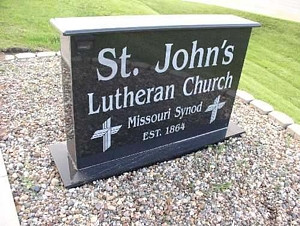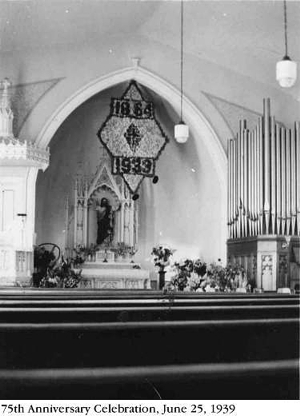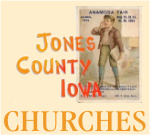THE HISTORY OF ST. JOHN'S EVANGELICAL LUTHERAN CHURCH OF MONTICELLO IOWA
From Their 75th Anniversary Booklet, 1939 &
125th Anniversary Booklet, 1989

 St. John's Lutheran Church in the extreme northeast of Wayne Township, Jones County, is one of the oldest, if not the oldest, and one of the strongest German church organizations in the county. Its history is the history of early Lutheranism in this part of the state. The church was organized on January 12th, 1864. Its history, however, antedates its organization by several years.
St. John's Lutheran Church in the extreme northeast of Wayne Township, Jones County, is one of the oldest, if not the oldest, and one of the strongest German church organizations in the county. Its history is the history of early Lutheranism in this part of the state. The church was organized on January 12th, 1864. Its history, however, antedates its organization by several years.
The nucleus of the church is to be found in a small Lutheran colony, comprising nine families and one single person in the neighborhood of the present site of the church, all coming across the Mississippi from Dixon, Lee county, Illinois. The colony was started when Jacob F. Matthiessen brought his family across the Father of Waters in May, 1857. He was accompanied by his brother-in-law, Gerhard Eilers, who at the time was still an unmarried man. They were followed by the families of Anton Eilers and Johann Hinrich Kleen in April, 1858; Nanne Hanken and Wessel B. Hanken in October, 1858; Heinrich Hanken in April, 1859; Gerhard Ahrend Zimmerman in May, 1859; Johann Jacobs in the fall of 1859 and Heinrich Jacobs in the spring of 1860.
During practically the entire triennial period of colonization these early settlers were obliged to forgo the blessings of public worship. When the year 1860 passed into history, they had been privileged but a half dozen times to hear a professedly Lutheran minister in their midst. Even this would have been denied them, had not a missionary by the name of Altmeyer discovered their settlement and preached for them and ministered over them as often and as much as his extensive travels through the vast area of thinly populated country permitted.
It was not until the dawn of 1861, that matters began to crystallize and take on shape towards the formation of a church body. In January of this year, the Rev. Robert Oswald, stationed at Marion, Linn county, Iowa, undertook an exploration trip into the field abandoned by Rev. Altmeyer. From this time on some degree of regularity was established, though services were not a frequent occurrence as yet by any means. In October of the same year, however, he too found himself compelled to abandon his missionary work at this place. After a lapse of more than twelve months, another minister, Rev. George Reinsch, arranged to look after the spiritual wants of the congregation and continued to do so from December, 1862, until some time in the fall of 1863. By this time the German colony had grown to such an extent, that the question of organizing a church and calling a minister into its pastorate, was earnestly considered. A few deaths in the settlement about this time seemed to greatly emphasize the advisability and necessity of so doing. Therefore, when the year 1864 had barely been ushered in, planning ceased, and action began. On January 12th, a meeting was called for the purpose of organizing, and considering the purchase of property for the church and cemetery purposes. A constitution was adopted, and the following twenty-two signatures were affixed thereto: Anton Eilers, A. H. Hanken, A. G. Zimmerman, N. A. Hanken, Ludwig Pause, Heinrich Heeren, W. H. Helgens, Michael Heeren, J. H. Heeren, Johann T. Mue1ler, August Schatz, H. A. B. Toel, Tobias Tobiassen, W. B. Hanken, Albert Siemers, Heinrich Vanderham, J. Null, Gerhard Eilers, Jacob F. Matthiessen, Heinrich Jacobs, Heinrich J. Jacobs, Christoph Scheer. The Messrs. Jacob F. Matthiessen, Ludwig Pause and Anton Eilers were elected officers.
Several reasons, as the absence of a parsonage and the like, stood against. the advisability of immediately calling a resident pastor, and so action in this matter was postponed until a later date. The Rev. Herman Rehwoldt of Dubuque, who had conducted the funeral services for Mrs. John Jacobs in December, 1863, seeing the plight of the congregation, consented to arrange his affairs in such a manner as to enable him to provide also this congregation with preaching at stated intervals until they should be in a position to call a pastor of their own.
Being thus temporarily provided for, the newly organized congregation began immediately to arrange matters for a permanent and local ministry. The question of providing a church and a parsonage confronted them, Thus far, a small country school house, situated on what is now known as the George McKeever farm, furnished ample accommodations for all. During the summer of 1865, a building plan was carried into execution which brought church and parsonage under one roof. The upper story was arranged for holding services and the lower story, plus the basement, furnished a place of habitation for the pastor and his family. After all the preliminary arrangements had been completed, Rev. Rehwold withdrew, and on December 1, 1865, the first resident pastor, Rev. G. H. Brecht was installed.
The next six years passed by without anything particularly noteworthy happening with probably this one exception, that when Rev. Brecht had resigned his pastorate in March, 1869, and his successor, Rev. Franz B. Cunz had also handed in his resignation during the summer of 1870, both being called to other fields of labor, the congregation, under the guidance of Rev. L. Osterhus, of Dubuque, who had preached here during the vacancy, extended a call for the first time to a minister of the Synod which has furnished the congregation with pastors ever since, and in which the congregation holds membership today. The new minister was Rev. Lorenz Traub, a member of the Lutheran Synod of Missouri, Ohio and other states. He was installed on June 18, 1871 and remained at the head of the congregation until October 6, 1872.
The summer of 1872 brought about a change of vital importance for the future and this change also accounts for the fact that St. John's congregation is no larger numerically today than will be stated hereinafter. During this summer the congregation was divided because of dissatisfaction in some quarters over the location of the church property, some claiming that it should have been more centrally located. The members living toward the southwest of the church branched off, organizing a new congregation under the name of Zion's Lutheran church, and erected a church building of their own. This was the beginning of what is today known as Zion's Lutheran church of Wayne Center.
When Rev. Traub accepted a call into a different field shortly after this separation had taken place, the two congregations, in good harmony, jointly called a minister to take charge of them, with the expressed understanding, that he was to change his place of habitation annually, living at Sand Hill in the midst of St. John's congregation one year, and at Wayne Center in the midst of Zion's congregation the next. The purpose thereof was the presumably better end gained in the catechetical instruction of the children at both places. The man thus doomed to perpetual motion was the Rev. J. J. Oetjen, who entered upon his pastoral and educational duties in April, 1873 and continued therein until July 1879, during the last year, however, ministering over St. John's congregation only. During his ministry, in 1877. the church property, thirty by forty-five feet was erected by St. John's congregation and the upper story of the parsonage given over to school purposes.
In 1878 Zion's Lutheran Church called Pastor C. C. Mardorf of the Iowa Synod to minister to its spiritual needs, leaving Rev. J. J. Oetjen to serve only St. John's during the remainder of his pastorate here. In 1879, when Rev. Oetjen left for his new field in Wisconsin, the congregation called a young man who had just finished his studies in the Concordia Theological Seminary at St. Louis, Missouri. This was the Rev. Fritz von Strohe. He was installed in September, 1879, and accepted a call to Collinsville, Illinois, June 10, 1900, after almost twenty-one years of untiring service. Rev. von Strohe was a man of more than ordinary tact and ability.
In 1880 the congregation voted to join the Synod of Missouri, Ohio and other states. In the same year, a resolution to incorporate was passed, and the Messrs. Christ Scheer, Henry Heeren and Henry Hanken were elected trustees. In 1884, a schoolhouse was built and the entire parsonage turned over to the private use of the pastor.
On August 19, 1900, Rev. W. H. L. Schuetz, was installed to succeed Rev. von Strohe. In 1907 the congregation enlarged and remodeled its church. In 1911 the old parsonage was razed and a fine, large and modern parsonage erected in its place. In commemoration of its fiftieth anniversary, the congregation in 1914 installed a beautiful two manual Weickhardt pipe organ with a power driven blower. During the summer of 1915 the congregation erected a neat little branch church with high basement at Johnstown, known as Trinity, for the purpose of giving its members in that locality better church and school accommodations.
Rev. Schuetz labored faithfully for the parochial school and during his 23 years of service in St. John's, the congregation was solidified and prospered in every way. In 1923 he accepted a call to Beecher, Illinois, where he still holds his pastorate.
In the fall of 1923, Rev. Paul T. Gutknecht of Niagara Falls, New York, received and followed the call to St. John's. He was installed by the Rev. Kettler of Delaware on November 4th.
 In the year 1924 the congregation showed its progressive spirit by installing in the parsonage a modern electrical water pressure system. Since that time the congregation has held its own and has steadily improved its property. In 1930, the church was renovated, new pews were installed and a new floor laid. In 1937 new church windows of beautiful design were added to the church. The old barns were removed and new ones built in 1938. At this time also, the congregation first built a basement under the church, installed an efficient oil burning heating plant which will also serve as an air conditioner in the summer for the church building, while the Ladies Aid again had the church redecorated and installed new lights. All of the buildings of the church property were repainted so that at the time of our 75th anniversary of the congregation the whole church property has a decidedly neat appearance.
In the year 1924 the congregation showed its progressive spirit by installing in the parsonage a modern electrical water pressure system. Since that time the congregation has held its own and has steadily improved its property. In 1930, the church was renovated, new pews were installed and a new floor laid. In 1937 new church windows of beautiful design were added to the church. The old barns were removed and new ones built in 1938. At this time also, the congregation first built a basement under the church, installed an efficient oil burning heating plant which will also serve as an air conditioner in the summer for the church building, while the Ladies Aid again had the church redecorated and installed new lights. All of the buildings of the church property were repainted so that at the time of our 75th anniversary of the congregation the whole church property has a decidedly neat appearance.
During the summer of 1943 the parsonage was extensively remodeled. After serving the congregation for 21 years the Rev. Gutknecht received a call to Belding, Michigan. The Rev. R. P. Young of Victor, Iowa, was called to replace him and was installed on April 27, 1944.
It was about this time that improved transportation made it unnecessary to continue services at Trinity, Johnstontown, and a majority of its members joined St. John's congregation. A committee was appointed in 1944 to dispose of the property. The language used in the congregation had gradually changed to the American and in 1950 services in the German language were discontinued. The Rev. Young served the congregation energetically and faithfully until the Lord called him to his eternal rest on December 27, 1952. To fill the vacancy caused by Pastor Young's death, a call was extended to the Rev. August Stenzel of St. Louis, Missouri. He was installed May 17, 1953.
For about ten years there was much discussion as to the advisability of remodeling the church on the present property or of relocating. A decision was reached in August 1957 and an extensive remodeling program was immediately begun. The last service was held in the original church on September 29, 1957. The church was moved to its present location. The seating capacity was increased from 165 to 285. The church now has a full basement with a modern kitchen and hot water heating. The organ was completely rebuilt. New furnishings were placed into the chancel and new pews were added. The total cost of this project was some $59,000. Those remembering the church as it was before received the impression that this is an entirely new building. The first Service, a Lenten service, was held in the basement on February 18, 1958. Dedication services were held on June 15, 1958.
In August of the same year, the Rev. Stenzel accepted a position as full-time prison chaplain at Hagerstown, Maryland. Towards spring a call was extended to the present pastor, C.C. Gutekunst, of Storm Lake, Iowa, and he was installed on April 5. 1959.
Much emphasis is placed by the congregation on the care of the children and young people in its midst. Sunday School, Vacation Bible School, and Saturday catechetical instructions are conducted regularly with a staff of consecrated workers from the congregation. The Young people have an active society with membership in International Walther League. Forty-five ladies of the congregation are members of the local Ladies' Aid and also take part in the Lutheran Women's Missionary League of the Lutheran Church—Missouri Synod. Though a hundred years old, the congregation still manifests a spirit of youth and vigor with plans and ambitions for the future.
As a memorial for the centennial of the congregation a stone church marker has been erected into which the important papers and history of the congregation, usually placed into the cornerstone of the church, have been placed. This marker was dedicated to the glory of God in thanksgiving for 100 years of the preaching of the pure Word on January 12, 1963.
During the 100 years of its existence three sons of the congregation have entered into the holy ministry: The Reverends Henry E. Jacobs, John Rickels, and Rufus Young. Two young men are at present preparing themselves for full time work in the church.
As of January 1, 1964 the congregation numbers 300 communicant members and 435 souls. The complete list of pastors who have held office is as follows:
The Rev. Altmeyer | No record of exact dates | |
| The Rev. Robert Oswald | Jan. 1861 to Oct. 1861 | |
| The Rev, George Reinsch | Dec.25 1862 to fall 1863 | |
| The Rev. Herman Rehwoldt | July 1864 to Aug. 1865 | |
| The Rev. G. H. Brecht | Dec. 1865 to Mar. 1869 | |
| The Rev. Franz B. Cunz | July 25, 1869 to summer 1870 | |
| The Rev. L. Osterhus | Several months during vacancy | |
| The Rev. Lorenz Traub | June 18, 1871 to Oct.6,1872 | |
| The Rev. J. J. Oetjen | Apr. 1873 to July 1879 | |
| The Rev. Friedrich Von Strohe | Sept. 1879 to June 10, 1900 | |
| The Rev. Wm. H. L. Schuetz | Aug. 19, 1900 to August 1923 | |
| The Rev. Paul Gutknect | Nov. 4, 1923 to spring 1944 | |
| The Rev. Rufus P. Young | Apr. 27, 1944 to his death Dec. 27, 1952 | |
| The Rev. August Stenzel | May 17, 1953 to August 1958 | |
| The Rev. Carl C. Gutekunst | April 5, 1959 to fall 1970 |
The following served as teachers during the years that parochial school was in existence: Elsie Behrends, Paul Schuetz, Walter Melahn, Edward Bonnin, Lethan Briehan, Kurt Daib, Fred Duecker, Carl Hueile,
At Trinity, Johnsontown, there were the following: Adella Matthias, Fred Duecker, Wilhelm Baumann.






